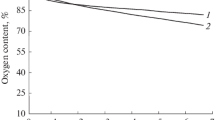Summary
The kinetics of fat cell adenylyl cyclase were studied, with AMP-P(NH)P and Mn++ or Mg++ as the divalent cation. In general, the reaction times were not linear. In the presence of fluoride or GMP-P(NH)P, the time curves were concave upwards; in other cases (i.e., basal activity, insulin, or isoproterenol), transient rates tended to decrease with time during the assay. Kinetic data were analyzed according to a previously described procedure (Torreset al., 1978b) which isolates two kinetic components: initial and final.
With AMP-P(NH)P, kinetic activities were about ten times lower than those for ATP. With Mn++, activities were at least two-times higher than for Mg++.
Spontaneous inactivation of adenylyl cyclase was higher in assays containing Mg++ than in those supplemented with Mn++. In the latter case, insulin was able to increase the inactivation rate. Fluoride and isoproterenol both activated adenylyl cyclase in both the initial and final kinetic components; under most of the conditions explored, their effects on the final component appeared to be more dramatic. Assays with GMP-P(NH)P showed inhibited activity in the initial component and increased activity in the final one.
When the results obtained with AMP-P(NH)P are compared with those of ATP (Torreset al., 1978b. J. Membrane Biol. 43:000), the following differences were found: (i) in the presence of insulin and Mn++, cyclase inactivation was higher with AMP-P(NH)P than with ATP; (ii) fluoride stimulation of the final component was more marked with ATP than with AMP-P(NH)P; (iii) cyclase stimulation by isoproterenol was slightly higher with the nucleotide analog; and (iv) GMP-P(NH)P stimulation of the final component resulted in higher activity with ATP than with AMP-P(NH)P.
Similar content being viewed by others
References
Birnbaumer, L., Yang, P.C. 1974. Studies on receptor mediated activation of adenylyl cyclase. I. Preparation and description of general properties of an adenylyl cyclase system in beef renal medullary membranes sensitive to neurohypophyseal hormones.J. Biol. Chem. 249:7848
Birnbaumer, L., Yang, P.C., Hunzicker-Dunn, M., Bockaert, J., Duran, J.M. 1976. Adenylyl cyclase activities in ovarian tissues. I. Homogenization and conditions of assay in graafian follicles and corpora lutea of rabbits, rats and pigs; Regulation by ATP and some comparative properties.Endocrinology 99:163
Bockaert, J., Hunzicker-Dunn, M., Birnbaumer, L. 1976. Hormone-stimulated desensitization of hormone-dependent adenylyl cyclase.J. Biol. Chem. 251:2653
Constantopoulos, A., Najjar, V.A. 1973. The activation of adenylate cyclase. II. The postulated presence of (A) adenylate cyclase in a phospho (inhibited) form, (B) a dephospho (activated) form with a cyclic adenylate stimulated membrane protein kinase.Biochem. Biophys. Res. Commun. 53:794
Helmreich, E.J.M., Zenner, H.P., Pfeuffer, T., Cori, C.F. 1976. Signal transfer from hormone receptor to adenylate cyclase.In: Current Topics in Cellular Regulation. B.L. Horecker and E.R. Stadtman, editors. Vol. 10, pp. 41–87. Academic Press, New York
Hunzicker-Dunn, M., Birnbaumer, L. 1976a. Adenylyl cyclase activities in ovarian tissues. II. Regulation of responsiveness to LH, FSH, and PGE1 in the rabbit.Endocrinology 99:185
Hunzicker-Dunn, M., Birnbaumer, L. 1976b. Adenylyl cyclase activities in ovarian tissues. III. Regulation of responsiveness to LH, FSH and PGE1 in the prepuberal, pregnant and pseudopregnant rat.Endocrinology 99:198
Hunzicker-Dunn, M., Birnbaumer, L. 1976c. Adenylyl cyclase activities in ovarian tissues. IV. Gonadotrophin induced desensitization of the luteal adenylyl cyclase throughout pregnancy and pseudopregnancy in the rabbit and the rat.Endocrinology 99:211
Johnson, R.A. 1977. Hydrolysis of 5′ adenylylimidodiphosphate [AMP-P(NH)P]; Implication for the study of adenylate cyclase (AC).Fed. Proc. 36:736
Khan, J., Martell, A.E. 1966. Thermodynamic quantities associated with the interaction of adenosine triphosphate with metal ions.J. Am. Chem. Soc. 88:668
Manganiello, V.C., Vaughan, M. 1976. Activation and inhibition of fat cell adenylate cyclase by fluoride.J. Biol. Chem. 251:6205
Najjar, V.A., Constantopoulos, A. 1973. The activation of adenylate cyclase. I. A postulated mechanism for fluoride and hormone activation of adenylate cyclase.Mol. Cel. Biochem. 2:87
Perkins, J.P., Moore, M.M. 1971. Activation by sodium, fluoride and detergents.J. Biol. Chem. 246:62
Rodbell, M., Birnbaumer, L., Pohl, S.L., Krans, H.N.L. 1971. Cyclase system in plasma membrane of rat liver. V. An obligatory role of guanyl nucleotides in glucagon activation.J. Biol. Chem. 246:1877
Rodbell, M., Lin, M.C., Salomon, Y. 1974. Evidence for interdependent action of glucagon and nucleotides on the hepatic adenylate cyclase system.J. Biol. Chem. 249:59
Salomon, Y., Lin, M.C., Lodos, C., Rendell, M., Rodbell, M. 1975. The hepatic adenylate cyclase system. I. Evidence for transition states and structural requirements for guanine nucleotide activation.J. Biol. Chem. 250:4239
Torres, H.N., Flawiá, M.M., Hernaez, L., Cuatrecasas, P. 1978a. Effects of insulin on the adenylyl cyclase activity of isolated fat cell membranes.J. Membrane Biol. 43:1
Torres, H.N., Flawiá, M.M., Medrano, J.A., Cuatrecasas, P. 1978b. Kinetic studies of adenylyl cyclase of fat cell membranes. I. Comparison of activities measured in the presence of Mg++-ATP and Mn++-ATP. Effects of insulin, GMP-P(NH)P, isoproterenol, and fluoride.J. Membrane Biol. 43:19
Yount, R.G., Babcock, D., Ballantyne, W., Ojala, D. 1971a. Adenylyl imidodiphosphate, an adenosine triphosphate analog containing a P-N-P linkage.Biochemistry 10:2484
Yount, R.G., Ojala, D., Babcock, D. 1971b. Interaction of P-N-P and P-C-P analogs of adenosine triphosphate with heavy meromyosin, myosin and actomyosin.Biochemistry 10:2490
Author information
Authors and Affiliations
Rights and permissions
About this article
Cite this article
Torres, H.N., Flawiá, M.M., Medrano, J.A. et al. Kinetic studies of adenylyl cyclase of fat cell membranes. J. Membrain Biol. 43, 45–69 (1978). https://doi.org/10.1007/BF01869041
Received:
Issue Date:
DOI: https://doi.org/10.1007/BF01869041




